San Martin is home to various birds, from rare and endangered species to common backyard birds.
The area is known for its lush forests, grasslands, and wetland habitats that provide ideal nesting and feeding grounds for some of the most beautiful birds in the world.
Birders come from all around the world to spot some of the more than 170 species of birds that call San Martin home, including the endangered California Condor, the majestic Bald Eagle, and the colorful Acorn Woodpecker.
In addition to the wide variety of species, San Martin provides a great opportunity for birders to observe the birds in their natural habitats.
With its diverse habitats and abundance of bird species, it’s no wonder that San Martin is an ideal destination for birders.
1. Red Knot
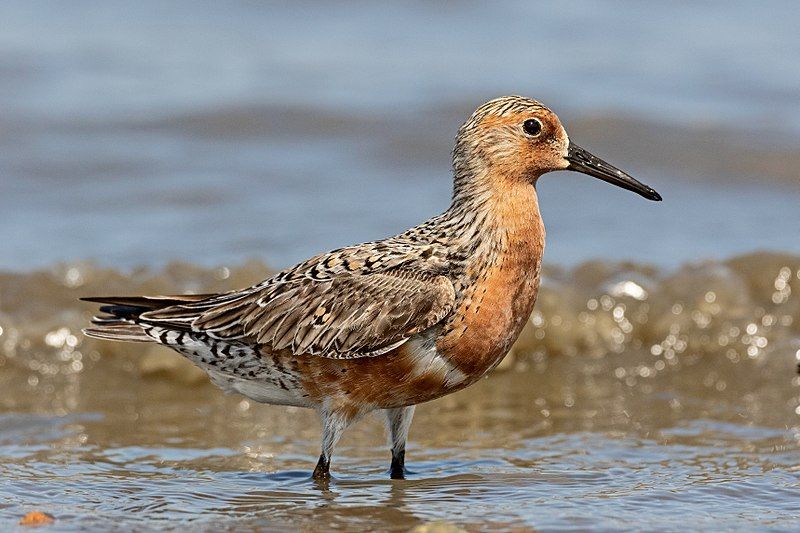
The red knot, or just knot, is a medium-sized shorebird found in the tundra and Arctic Cordillera. It is a member of the Calidris sandpiper family and is the second-largest species of this family, only surpassed by the great knot.
The red knot has six recognized subspecies, each with distinct physical characteristics. The bird is known to breed in the far north of Canada, Europe, and Russia and migrate to other parts of the world during winter.
It has an overall greyish-brown coloration with a reddish-chestnut head, neck, and underparts. It has a round head, short bill, and long legs, and can reach up to 24 centimeters in length.
The red knot is an omnivore, meaning it can feed on various food sources such as insects, crustaceans, mollusks, worms, and plant material. It forages in shallow waters for food, which it finds by probing into mudflats with its bill.
The red knot is listed as a Near Threatened species on the IUCN Red List due to the loss of its habitat, hunting, and the effects of climate change. Conservation efforts are being made to protect the species, such as protecting its habitats and limiting hunting.
| Kingdom | Animalia |
| Phylum | Chordata |
| Class | Aves |
| Order | Charadriiformes |
| Family | Scolopacidae |
| Genus | Calidris |
| Species | C. canutus |
2. Magnificent Frigatebird
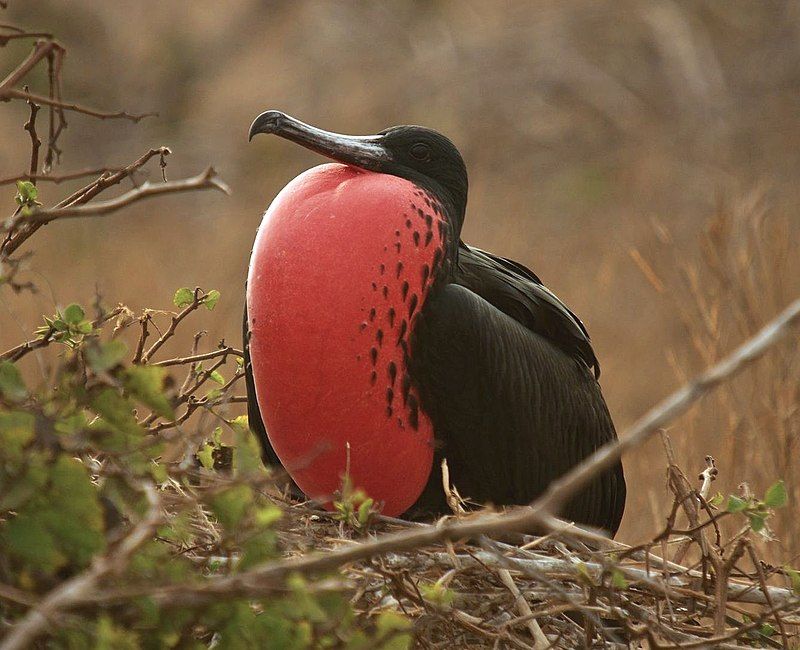
The magnificent frigatebird is a seabird species belonging to the family Fregatidae. It is an impressive bird, with a size that sets it apart from other species of frigatebirds.
Its body length is between 89 and 114 centimeters (35 to 45 inches), and its wingspan can measure between 2.17 and 2.44 meters (7 to 8 feet).
This makes it the largest species of frigatebird that can be found. Their wings are long and pointed, and they have a forked tails.
They are also characterized by their large, red pouch that they inflate to attract a mate or to show aggression to other birds. The male frigatebirds are all-black with a green sheen, while the females and juveniles are brownish-black.
The magnificent frigatebird is usually found around islands in tropical and subtropical parts of the world, and they can be seen soaring above the ocean in search of food. They are powerful fliers and can stay in the air for hours.
They mainly feed on fish but also eat other types of food, such as jellyfish, squid, and crabs.
They also steal food from other seabirds, sometimes called the “pirates of the sky.” The magnificent frigatebird is an impressive bird species and has been admired for centuries.
Its size and power make it a unique species in many parts of the world.
| Kingdom | Animalia |
| Phylum | Chordata |
| Class | Aves |
| Order | Suliformes |
| Family | Fregatidae |
| Genus | Fregata |
| Species | F. magnificent |
3. White-tailed Tropicbird
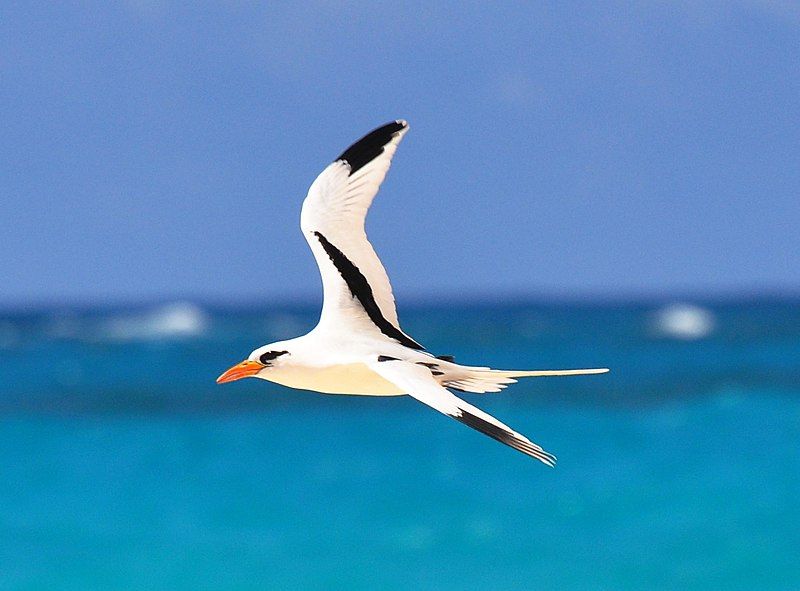
The white-tailed tropicbird is a seabird species of the order Phaethontiformes. It is the smallest of three closely related species of tropicbirds found in the tropical oceans of the Atlantic, Pacific, and Indian Oceans.
It is the smallest species, with an average length of around 70 cm. Its scientific name is Phaethon lepturus, and it has a distinctive white tail with black markings near the tip. It also has a black mask around the eyes and a white head with a yellow crown.
Its wings are long and pointed, and it has a hooked bill. It has a vocalization that is described as a loud, high-pitched scream. The white-tailed tropicbird is a pelagic bird that typically lives and feeds in the open ocean far from the shore.
It feeds on fish, squid, and crustaceans and is known to forage by hovering over the water surface and plunging into the water to catch its prey. It also sometimes feeds on carrion. These birds usually nest in colonies, often in trees or on cliff ledges.
They lay one to three eggs in a nest of grass, leaves, and feathers. The young are tended to by both parents. The white-tailed tropicbird is listed as least concern on the IUCN Red List, meaning it is not in danger of becoming extinct.
However, it is threatened by habitat loss, degradation, and fishing operations in some areas. Some cultures also hunt them for food and feathers.
| Kingdom | Animalia |
| Phylum | Chordata |
| Class | Aves |
| Order | Phaethontiformes |
| Family | Phaethontidae |
| Genus | Phaethon |
| Species | P. lepturus |
4. Solitary Sandpiper
The solitary sandpiper is a small shorebird belonging to the genus Tringa.
The genus name was given by Aldrovandus in 1599, and it is derived from the Ancient Greek word trungas, which was used to describe a white-rumped, thrush-sized wading bird that was observed bobbing its tail.
The species name “solitaria” is Latin for “solitary” and comes from the Latin word solus, meaning “alone”. This name is appropriate for the solitary sandpiper, as it is often found alone and away from other birds.
The solitary sandpiper is an important species, as it is known to be a good indicator of the health of wetlands and other habitats.
| Kingdom | Animalia |
| Phylum | Chordata |
| Class | Aves |
| Order | Charadriiformes |
| Family | Scolopacidae |
| Genus | Tringa |
| Species | T. solitaria |
5. Oystercatchers
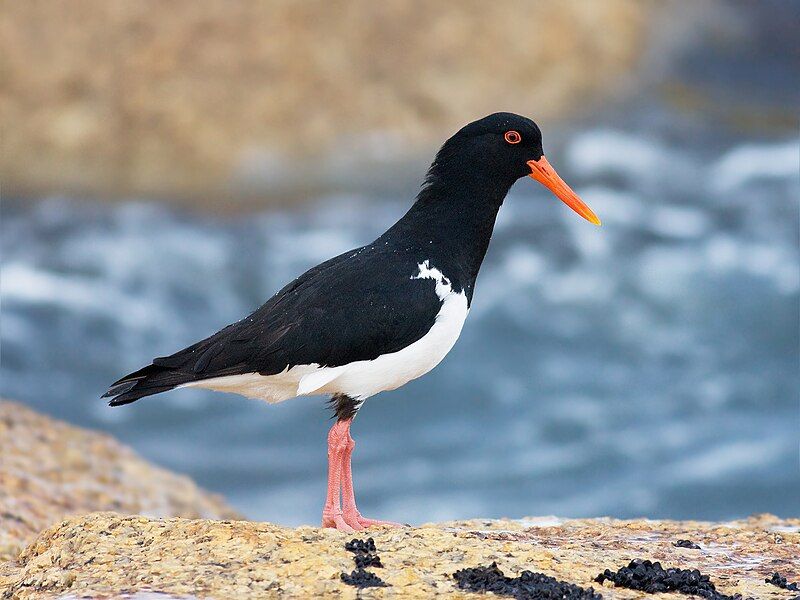
The oystercatchers are a type of wading bird belonging to the family Haematopodidae, which consists of only one genus, Haematopus. These birds can be found in coastal areas worldwide, except for the polar regions and some tropical areas in Africa and South East Asia.
Oystercatchers are large birds, typically measuring between 15 and 25 inches in length. They have long, bright red bills, and their feathers are usually black, white, and gray. Their diet mainly consists of mollusks, worms, and crustaceans.
Oystercatchers form large flocks when they are not breeding, and they are usually seen on mudflats and beaches. They are also known for their loud, screeching calls, which are used to communicate with each other.
Oystercatchers are important indicators of the health of the ecosystems in which they live, which makes their conservation an important priority.
| Kingdom | Animalia |
| Phylum | Chordata |
| Class | Aves |
| Order | Charadriiformes |
| Family | Haematopodidae |
| Genus | Haematopus |
6. Black-necked Stilt
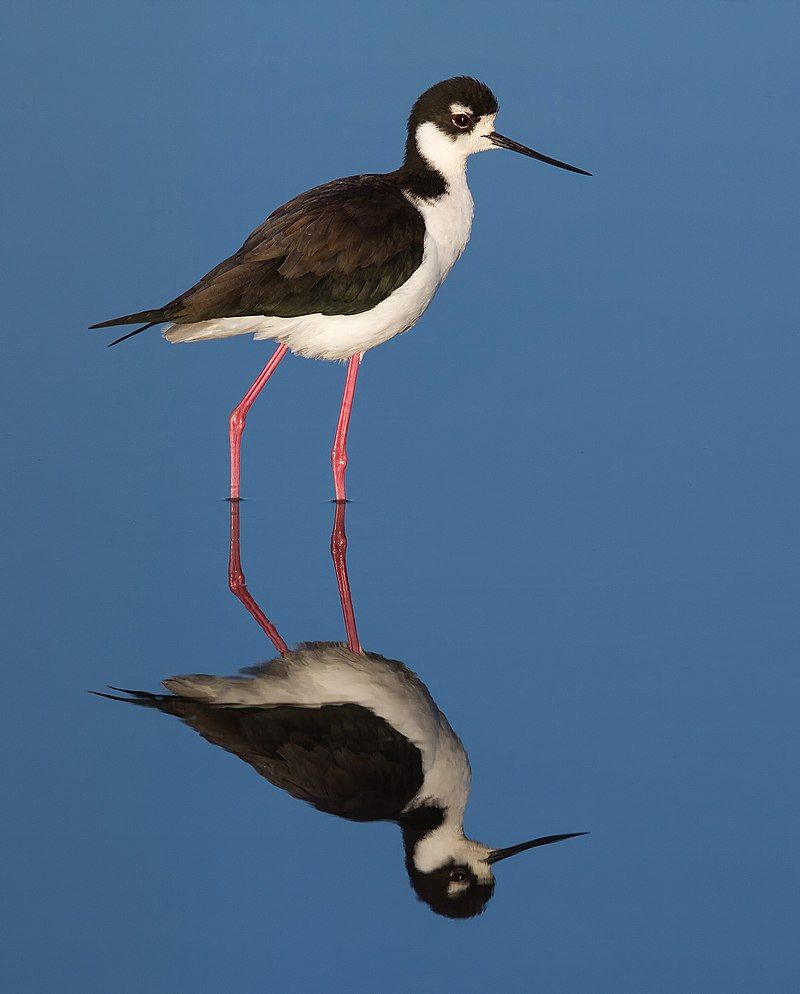
The black-necked stilt is a species of waterbird found in wetlands and coastal regions in North America. It is a locally abundant species in the United States, found as far north as California and south as the interior western United States.
The bird is also found along the United States Gulf Coast, from Texas to Florida. The species is also found in parts of Mexico, Central America, and the Caribbean islands. This stilt species has a long, slender black bill and a long, slender black neck.
Its wings are black with white shoulders and a white underbelly. Its legs are bright red or pink, and it has a black head and white cap. The species can be seen wading in shallow water or mudflats, searching for food.
It feeds on small insects, crustaceans, and other aquatic invertebrates. The black-necked stilt is a migratory species, and it can often be seen in large flocks in the shallow waters of its breeding grounds.
Its breeding season usually starts in late spring and continues until early autumn. During the breeding season, the male and female will build a nest of grass and twigs in shallow water, often near a shoreline.
The female will lay up to four eggs, which are incubated by both parents. The black-necked stilt is listed as a species of least concern by the IUCN Red List of Threatened Species and is considered to be in good health overall.
The species is protected in many parts of its range but is still vulnerable to habitat destruction and other human-related disturbances. Its habitat must be conserved and protected to continue to protect this species.
| Kingdom | Animalia |
| Phylum | Chordata |
| Class | Aves |
| Order | Charadriiformes |
| Family | Recurvirostridae |
| Genus | Himantopus |
| Species | H. mexicanus |
7. American White Pelican
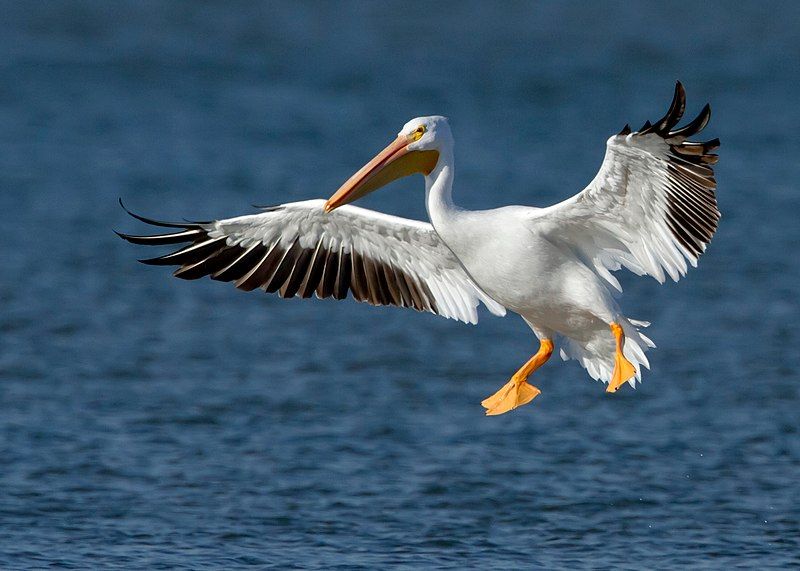
The American white pelican is an impressive species of bird that belongs to the Pelecaniformes order. This species can be found in parts of North America, where it breeds in the interior regions.
During the winter, it migrates south and can be found in coastal areas, with some individuals even reaching Costa Rica.
The American white pelican is a large bird with a wingspan of up to eleven feet. It has a distinctive bill, which is large and yellow, and a white plumage. Its feathers are waterproof, which helps the pelican when it dives into the water to catch its prey.
The American white pelican typically feeds on fish, which it catches by swimming and dipping its bill into the water. The American white pelican is also a strong, soaring bird.
It can be seen in the sky with its wings spread wide, gliding easily through the air. It is a magnificent sight to behold and a reminder of the beauty of nature. Overall, the American white pelican is an impressive species well-adapted to its environment.
Its large size and impressive wingspan make it an impressive sight, while its migratory habits and diet show its adaptability. This species is truly a marvel to behold.
| Kingdom | Animalia |
| Phylum | Chordata |
| Class | Aves |
| Order | Pelecaniformes |
| Family | Pelecanidae |
| Genus | Pelecanus |
| Species | P. erythrorhynchos |
8. White-rumped Sandpiper
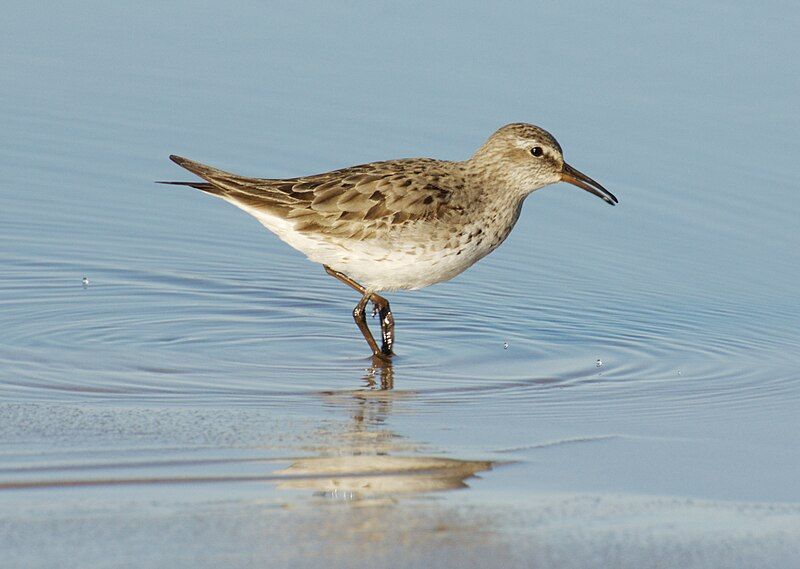
The white-rumped sandpiper is a small shorebird that inhabits the northern tundra of Canada and Alaska. It is one of several small shorebirds, collectively known as “peeps” or “stints,” and it can be difficult to identify because of its small size.
Due to their small size and the harsh environment of their habitat, these birds are not often seen or spotted. They feed mostly on small invertebrates, which they can find in the mudflats of their habitat.
The white-rumped sandpiper is a unique species, and it plays an important role in maintaining the balance of the ecosystem. It is also a migratory bird, which can travel thousands of miles during its annual migrations.
Therefore, preserving and protecting this species is important, as it is a valuable part of our natural world.
| Kingdom | Animalia |
| Phylum | Chordata |
| Class | Aves |
| Order | Charadriiformes |
| Family | Scolopacidae |
| Genus | Calidris |
| Species | C. fuscicollis |
9. Short-billed Bowitcher
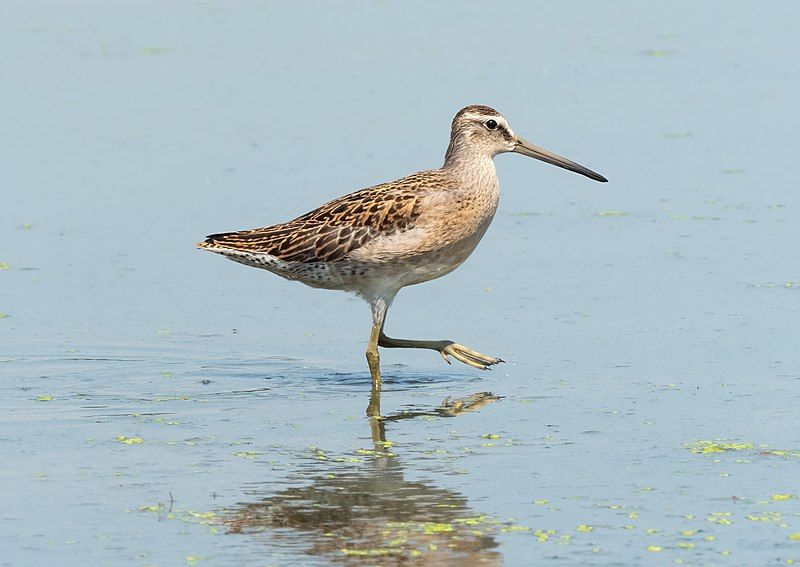
The short-billed dowitcher is a wading bird that belongs to the family Scolopacidae. It is closely related to its congener, the long-billed dowitcher. These birds are medium-sized, stocky, and have long bills, making them easily identifiable.
They are mainly found in North America, Central America, the Caribbean, and northern South America. The short-billed dowitcher is a solitary bird that feeds on aquatic organisms found in shallow water.
It typically forages by pecking its bill into the mud or sand to uncover prey. The diet of this bird consists of crustaceans, mollusks, and insects.
It also eats some plant material and seeds. The short-billed dowitcher inhabits various wetland habitats, from freshwater marshes to coastal estuaries. During the breeding season, it is found in moist meadows and grasslands.
During migration, it is found along mudflats, lake edges, and coastal salt marshes. The short-billed dowitcher is a fairly common bird. Its population is stable and is not considered threatened. It is also found in protected areas such as parks, reserves, and sanctuaries.
| Kingdom | Animalia |
| Phylum | Chordata |
| Class | Aves |
| Order | Charadriiformes |
| Family | Scolopacidae |
| Genus | Limnodromus |
| Species | L. griseus |
10. Bobolink
The bobolink is a small-sized bird native to the New World and the only species of the genus Dolichonyx. It is also known as the ‘rice bird’ because it feeds on cultivated grains during winter and migration.
This species is recognized by its black body, white patches on its wings, and a yellow patch on its nape.
During the breeding season, the male bobolink has a bright yellow breast and a white back, while the female is a duller version of the male. The bobolink is a migratory species, wintering in tropical areas of Central and South America.
During migration, they are found in the Great Plains and the Midwest, where they feed on grains and other plant matter.
They nest in grasslands and meadows, building cup-shaped nests on the ground or in low vegetation. The bobolink is a social species, often gathering in large flocks during migration and winter.
They communicate with each other using a variety of calls and songs, which are particularly loud and melodious during the breeding season. The bobolink is an important species in North America, as it helps to control insect populations in agricultural areas.
Unfortunately, habitat fragmentation and other human activities have caused a significant decline in the bobolink population in recent years. Conservation efforts are underway to help protect this beautiful species.
| Kingdom | Animalia |
| Phylum | Chordata |
| Class | Aves |
| Order | Passeriformes |
| Family | Icteridae |
| Genus | Dolichonyx |
| Species | D. oryzivorus |
11. Hudsonian Godwit
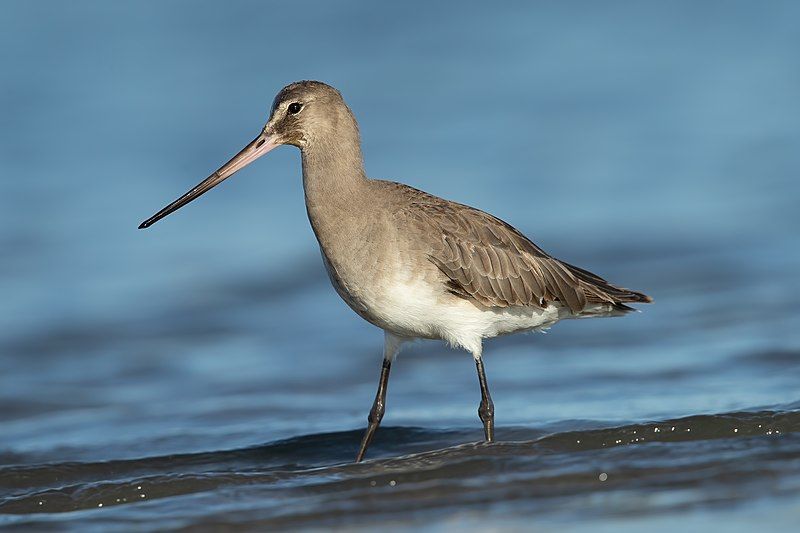
The Hudsonian godwit is a large shorebird in the family Scolopacidae, which is a type of sandpiper. Its scientific name, Limosa haemastica, is derived from Latin and Ancient Greek words. The genus name Limosa is derived from the Latin word limus, which means “mud”.
The specific name haemastica is derived from Ancient Greek and translates to “bloody”. This indicates the bird’s appearance, which is known for its reddish-brown breast.
An 18th-century name for the Hudsonian godwit was red-breasted godwit, which also reflects its distinctive color.
This species is widely distributed across the Americas, breeding in the boreal forests of Canada and Alaska and spending the winter in the southern United States and Central and South America.
The Hudsonian godwit is an important indicator of wetland health, as it is sensitive to changes in its habitat. Its conservation status is listed as Least Concern by the IUCN, indicating that it is not currently threatened with extinction.
| Kingdom | Animalia |
| Phylum | Chordata |
| Class | Aves |
| Order | Charadriiformes |
| Family | Scolopacidae |
| Genus | Limosa |
| Species | L. haemastica |
12. Greater Yellowlegs
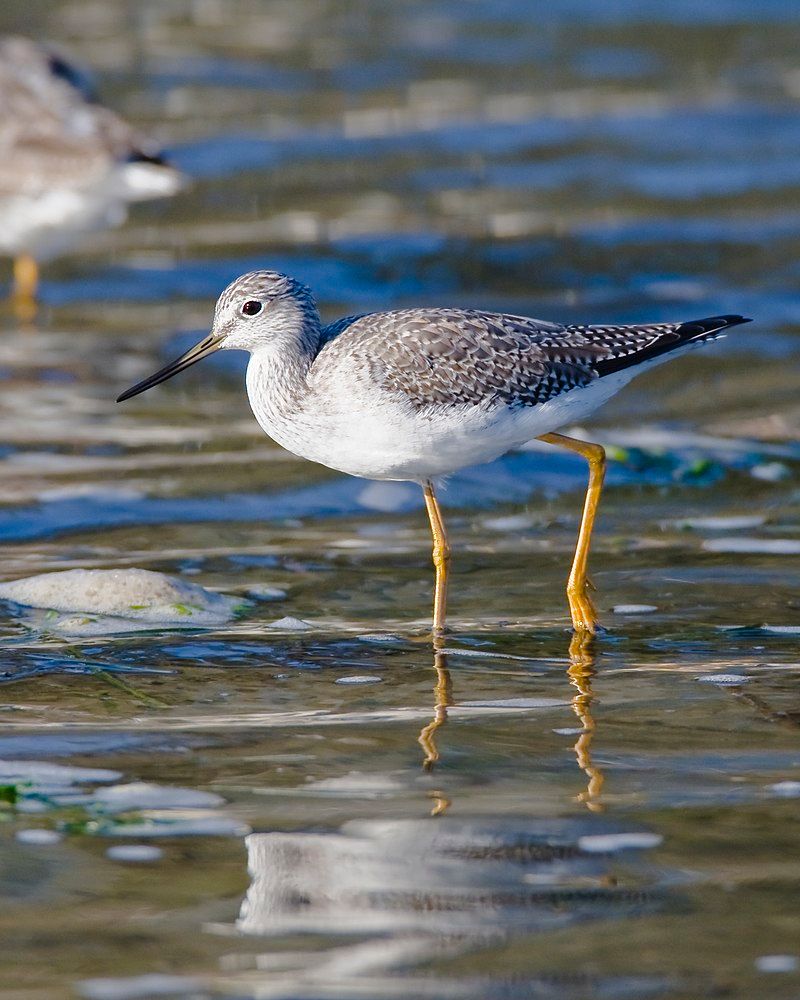
The greater yellowleg is a large shorebird that belongs to the Scolopacidae family. It is found in various habitats, from wetlands to coasts, and they are known for their distinct call.
During mating season, they migrate from their breeding grounds in central Canada and southern Alaska to winter in more temperate climates in southern North America, Central America, the West Indies, and South America.
They are highly adaptable birds, and they have evolved to be able to survive in a wide variety of environmental conditions. The greater yellowlegs have a long, slender bill adapted to their small fish, insects, and other invertebrates diet.
They have long, slender legs, which make them well-suited to navigating shallow wetlands. Their plumage is a mottled brown and white, with males typically coloring brighter than females.
During the breeding season, the males establish and defend territories, and the females construct a nest of grasses and other vegetation. The greater yellowlegs are a symbol of resilience and adaptability, as well as a beloved addition to many wetland habitats.
Its migrations are a reminder of the importance of conservation and the need to protect the species’ habitats. By studying the greater yellowlegs, we can learn more about how birds adapt to their environment and how to protect better and conserve their habitats.
| Kingdom | Animalia |
| Phylum | Chordata |
| Class | Aves |
| Order | Charadriiformes |
| Family | Scolopacidae |
| Genus | Tringa |
| Species | T. melanoleuca |
13. Buff-breasted Sandpiper
The buff-breasted sandpiper is a small shorebird classified in the Calidrid sandpiper family. Its species name, subruficollis, is derived from Latin words subrufus, meaning “reddish”, and collis, meaning “-necked/-throated”.
This name is given to the species because of its reddish-brown neck and throat. The buff-breasted sandpiper is a migratory species and can be found in both North and South America.
During the winter months, it can be seen in parts of South America, and during the breeding season, it can be found in the northern parts of the continent. It prefers to breed in dry, grassy areas or on rocky outcrops.
The buff-breasted sandpiper is an active and agile bird that feeds on small insects, spiders, and other invertebrates. It is a vocal species, and its song is often heard in its breeding habitat.
This species is considered a medium-sized shorebird, typically measuring between 20 and 22 cm in length.
| Kingdom | Animalia |
| Phylum | Chordata |
| Class | Aves |
| Order | Charadriiformes |
| Family | Scolopacidae |
| Genus | Calidris |
| Species | C. subruficollis |
14. Magnolia Warbler
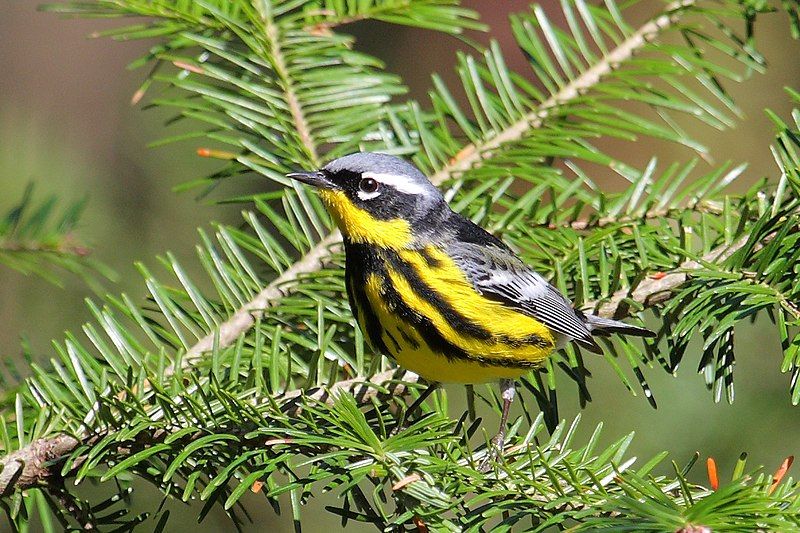
The Magnolia Warbler is a small migratory bird in North America that is part of the wood warbler family, known scientifically as Parulidae.
This family consists of more than 50 species of birds found in various habitats across North America, including open woodlands, wetlands, and parks. The Magnolia Warbler is easily recognizable due to its bright yellow plumage with black streaks.
It is also known for its long tail and pointed wings. During the breeding season, the Magnolia Warbler can be found in the northern parts of the United States, Canada, and Alaska. During the winter months, they migrate south to Central and South America.
They feed mainly on insects but will also eat seeds, fruits, and berries. The Magnolia Warbler is an important species for the environment, as it helps control insect populations and disperses seeds that will help maintain healthy forests.
| Kingdom | Animalia |
| Phylum | Chordata |
| Class | Aves |
| Order | Passeriformes |
| Family | Parulidae |
| Genus | Setophaga |
| Species | S. magnolia |
15. Caribbean Elaenia
The Caribbean elaenia is a species of bird belonging to the Family Tyrannidae. This species is widely distributed throughout the West Indies and Central America.
Its natural habitats include tropical and subtropical dry broadleaf forests, subtropical or tropical moist lowland forests, and even heavily degraded former forests.
The Caribbean elaenia is an opportunistic species, able to occupy a wide variety of habitats and adapt to environmental changes. It is primarily a frugivore, though it does also consume small insects.
Its diet consists of fruits, flowers, nectar, and small invertebrates. The Caribbean elaenia has various vocalizations and can produce loud, complex songs. It is a solitary species that prefers to remain in the cover of the trees.
The Caribbean elaenia is a common species throughout its range and is not considered to be threatened.
| Kingdom | Animalia |
| Phylum | Chordata |
| Class | Aves |
| Order | Passeriformes |
| Family | Tyrannidae |
| Genus | Elaenia |
| Species | E. martinica |
16. Masked Booby
The masked booby is a seabird belonging to the booby and gannet family, Sulidae. It is a large bird with a distinctive blue face and mask-like facial pattern.
The masked booby was first described by French naturalist René-Primevère Lesson in 1831 and is one of six species of booby in the genus Sula. It is found in tropical and subtropical areas and the Galapagos Islands.
It feeds mainly on fish, squid, crustaceans, and nests on the ground or in low bushes or trees. The masked booby is a strong flyer and can often be seen soaring high in the sky, looking for food.
It is also quite social, often forming large flocks to feed and roost.
| Kingdom | Animalia |
| Phylum | Chordata |
| Class | Aves |
| Order | Suliformes |
| Family | Sulidae |
| Genus | Sula |
| Species | S. dactylatra |
17. American Black Swift
The American black swift is a bird species found in a large area that spans from northern British Columbia in Canada to as far as Brazil.
It is an incredibly large range, and they are found in various habitats, including the United States, Mexico, Costa Rica, and the Caribbean. They are migratory birds, meaning they travel long distances to reach their destination.
Due to their wide range, they can be found in various habitats, including forests, mountains, and coastal regions. The black swift is a large bird with a body length of up to 9 inches and a wingspan of up to 25 inches.
They are black, with a white band and a white belly on their wings. They have a long, slender beak and long, pointed wings. Their flight is fast and direct, and they can catch flying insects mid-air.
The American black swift is a highly social bird and often flocks in large groups. They build their nests in the crevices of cliffs and rocks, and they are known to use old buildings and bridges for nesting sites.
They feed on various food sources, including flying insects, small birds, and carrion. The American black swift is an important bird species, and scientists monitor and study their population.
They are protected in the United States and Canada, and efforts are being made to conserve their habitats and populations. With proper habitat management and protection, we can ensure these fascinating birds can continue thriving.
| Kingdom | Animalia |
| Phylum | Chordata |
| Class | Aves |
| Clade | Strisores |
| Order | Apodiformes |
| Family | Apodidae |
| Genus | Cypseloides |
| Species | C. niger |
18. American Kestrel
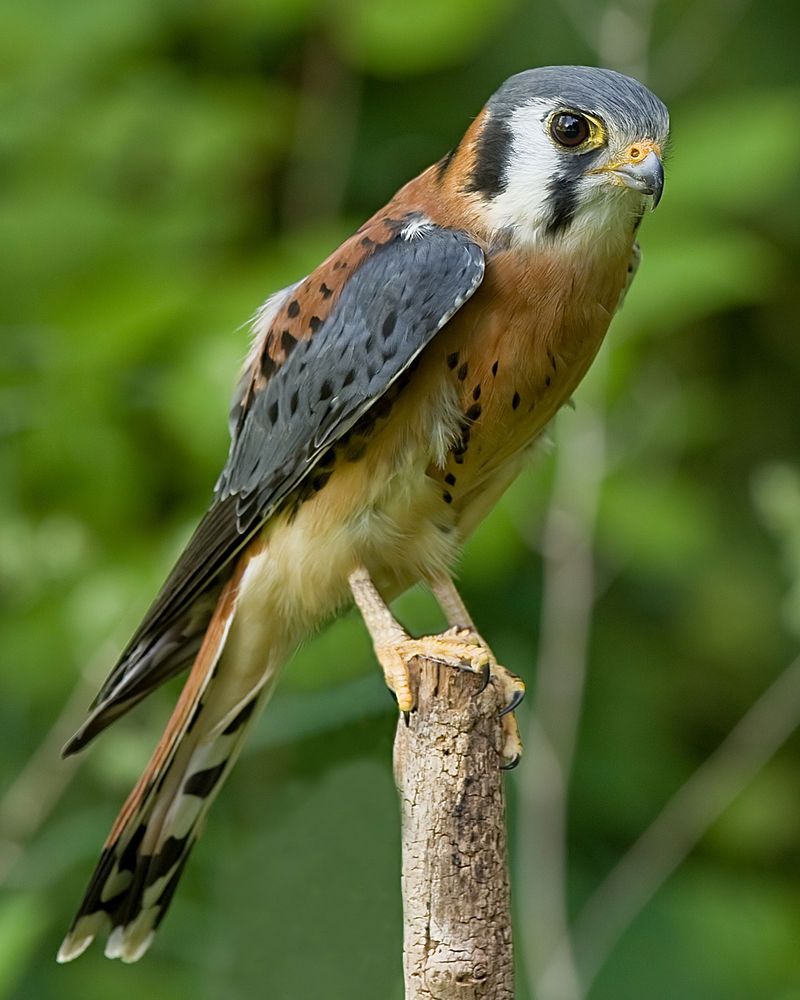
The American kestrel, also known as the sparrow hawk, is a falcon found in North America. It is the smallest and most common falcon species on the continent. The size of the American kestrel varies greatly between subspecies and sexes.
For example, the male kestrel can weigh as much as a blue jay, while the female kestrel may only weigh the same as a mourning dove. This range in size is approximately two-to-one, meaning that the male can be twice as large as the female of the same subspecies.
This size variation helps the American kestrel thrive in its environment, adapting to different prey sizes and habitats.
| Kingdom | Animalia |
| Phylum | Chordata |
| Class | Aves |
| Order | Falconiformes |
| Family | Falconidae |
| Genus | Falco |
| Species | F. sparverius |
19. Double-Crested Cormorant
The Double-Crested Cormorant is a species of waterbird belonging to the cormorant family. This species of waterbird is mainly found near rivers and lakes and in coastal areas.
The Double-Crested Cormorant is especially abundant in North America, ranging from the Aleutian Islands in Alaska south to Florida and Mexico.
This species is a common sight in many of North America’s temperate and subtropical regions, as it is well adapted to various habitats.
The Double-Crested Cormorant is mostly black and is easily recognizable by its two long, thin, white crests on its head. This species can grow up to three feet long and weigh up to four pounds.
They have webbed feet and long hooked bills to catch and eat their prey. The Double-Crested Cormorant is a voracious feeder and will eat anything from small fish and crustaceans to frogs, snakes, and even small birds.
The Double-Crested Cormorant is also a social species often seen in flocks. They communicate through various calls, including croaks, grunts, and whistles.
The breeding season of the Double-Crested Cormorant varies in different regions but generally takes place in late spring. They build their nests high up in trees or on the ground, and the female will lay 2 to 4 eggs per clutch.
The chicks will leave the nest after about 4 weeks and reach maturity after a few years. The Double-Crested Cormorant is an important species in many North American ecosystems.
It is an important food source for predators, including bald eagles, osprey, and great blue herons. It also helps keep the aquatic ecosystem balanced by controlling the populations of its prey species.
Despite its importance, the Double-Crested Cormorant is still at risk from habitat loss, pollution, and overfishing. Conservation efforts are needed to ensure that this species remains a part of the North American landscape for years to come.
| Kingdom | Animalia |
| Phylum | Chordata |
| Class | Aves |
| Order | Suliformes |
| Family | Phalacrocoracidae |
| Genus | Nannopterum |
| Species | N. auritum |
20. Ovenbird
The Ovenbird is a small songbird belonging to the New World warbler family. This bird migrates between two different regions on a seasonal basis. During the summer months, they can be found breeding in eastern North America.
Then, come winter, they travel south to areas such as Central America, some Caribbean islands, Florida, and northern Venezuela. The Ovenbird is a beautiful bird with a distinct call.
Its feathers are mainly brown with black stripes, a white eye stripe, and a reddish-brown crown. It is a ground-nesting bird whose nest is a domed structure of leaves and twigs.
It is usually located on the ground, near tree roots, or in shaded areas. The Ovenbird’s diet mainly consists of insects found on the ground or in low vegetation. It is an active forager and often moves around quickly when searching for food.
It is also known to eat some seeds and berries. The Ovenbird is a common migrant throughout its range and is a regular sight in many parks and gardens. It is a popular bird among bird watchers and is often seen in urban areas.
It is an important species in its habitat and plays an important role in controlling insect populations.
| Kingdom | Animalia |
| Phylum | Chordata |
| Class | Aves |
| Order | Passeriformes |
| Family | Parulidae |
| Genus | Seiurus |
| Species | S. aurocapilla |
21. Wood Duck
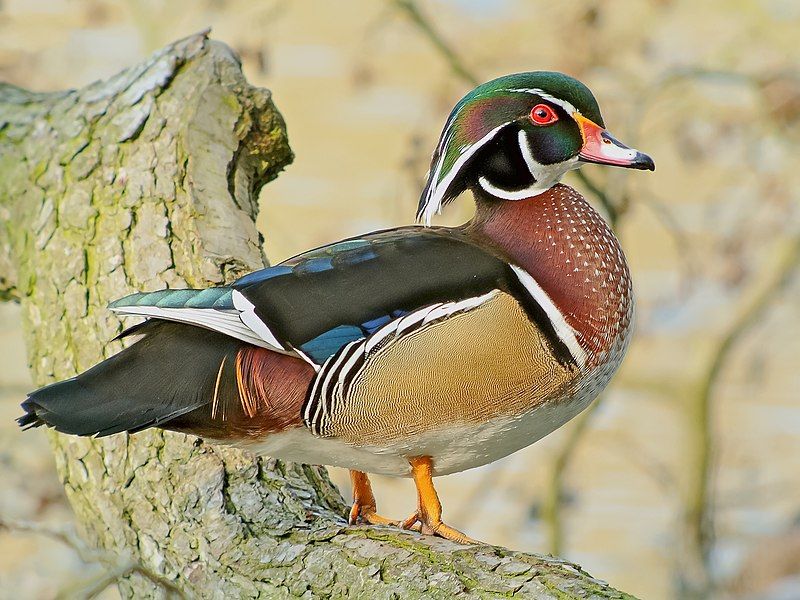
The wood duck, also known as the Carolina duck, is a species of perching duck found in North America. This species is highly prized for its beauty due to the brightly colored plumage of the male or drake.
The drake wood duck has an unmistakable appearance, with a bright green head, a white throat, chestnut sides, and white and black patterned wings. It also has a long, glossy, purple-black tail.
The colors of the drake wood duck make it one of the most colorful North American waterfowls, and it is one of the most popular birds for bird watchers and photographers. The female wood duck is also attractive but much less colorful than the drake.
She is mostly gray with a white throat and a white eye stripe. The wood duck is common in the United States, particularly in the country’s eastern half. It can be found in wooded swamps, marshes, ponds, and lakes.
The wood duck is an omnivore which eats plants and animals. Its diet consists of seeds, fruits, invertebrates, and small fish. Wood ducks are also known to eat acorns, which are important for the species in the winter months.
| Kingdom | Animalia |
| Phylum | Chordata |
| Class | Aves |
| Order | Anseriformes |
| Family | Anatidae |
| Genus | Aix |
| Species | A. sponsa |
22. American Bittern
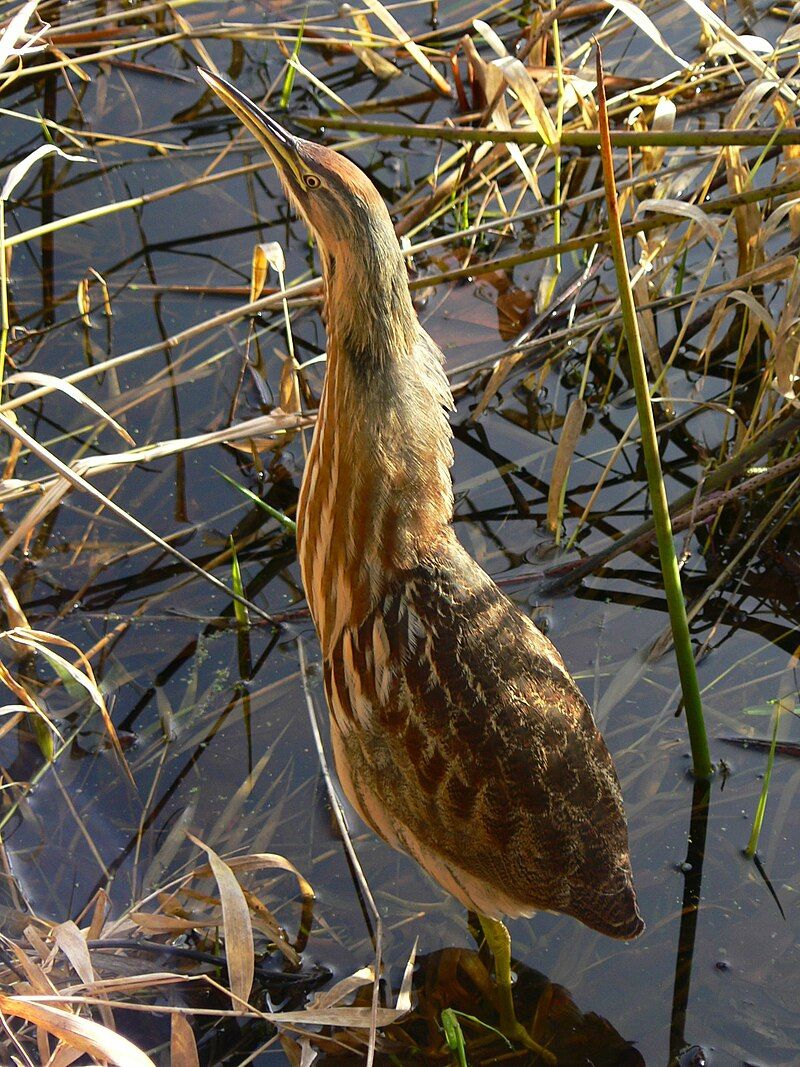
The American bittern is a wading bird species belonging to the heron family. It is found throughout the Nearctic region, encompassing parts of North and Central America.
It can be found in Canada and the northern and central parts of the United States during the breeding season.
During the winter, however, it migrates to the Gulf Coast states, all of Florida, including the Everglades, the Caribbean islands, and parts of Central America.
American bitterns are easily identifiable due to their long, curved neck and yellow-brown plumage.
This species is primarily solitary and sticks to wetland areas like marshes and swamps.
It feeds on small fish, crustaceans, insects, and amphibians, which it hunts by wading in shallow water and waiting patiently for prey.
Due to their wide distribution and diverse habitats, American bitterns have survived in many parts of the world.
However, they are still threatened by human activities such as construction and wetland destruction.
Conservation efforts have been put in place to protect this species and its habitats, and it is hoped that with continued efforts, the American bittern will be around for many years.
| Kingdom | Animalia |
| Phylum | Chordata |
| Class | Aves |
| Order | Pelecaniformes |
| Family | Ardeidae |
| Genus | Botaurus |
| Species | B. lentiginosus |
23. Blackpoll Warbler
The blackpoll warbler is a small songbird species found in the New World. They are easily identified by their plumage, which is mostly black and white. Male black warblers have a distinct black cap on their heads, white cheeks, and white wing bars.
The white wing bars are a key feature that can help differentiate them from other warbler species. During the breeding season, males also have a black throat and breast, white undersides, and white-tipped tails.
Blackpoll warblers are fairly small birds, measuring around five to six inches long, with a wingspan of around eight inches.
They are migratory birds, breeding in the forests of eastern North America and then wintering in the Caribbean and along the eastern and western coasts of South America.
| Kingdom | Animalia |
| Phylum | Chordata |
| Class | Aves |
| Order | Passeriformes |
| Family | Parulidae |
| Genus | Setophaga |
| Species | S. striata |
24. American Flamingo
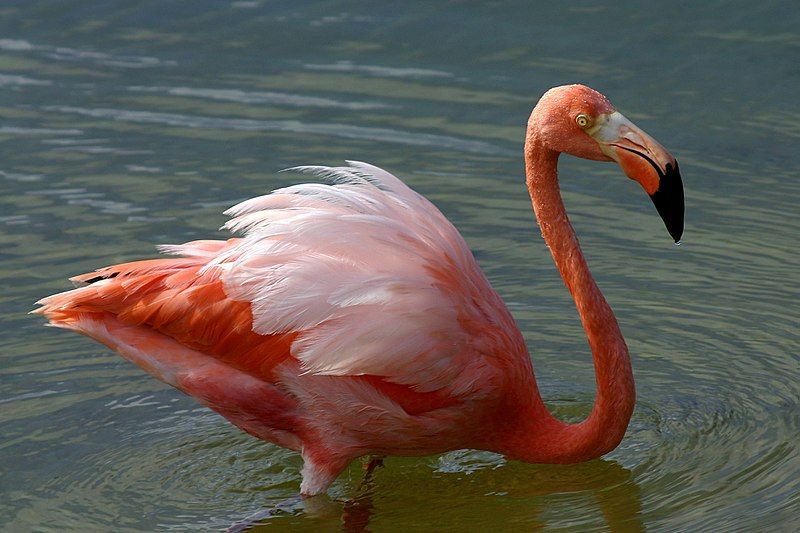
The American flamingo is a species found in the neotropics, regions located in Central and South America, and the Caribbean islands. It is closely related to the greater flamingo and the Chilean flamingo.
In the past, the American flamingo was grouped with the greater flamingo, and all three were considered the same species.
However, recent research has failed to provide concrete evidence to support this view, and now, the American flamingo is widely recognized as a separate species.
| Kingdom | Animalia |
| Phylum | Chordata |
| Class | Aves |
| Order | Phoenicopteriformes |
| Family | Phoenicopteridae |
| Genus | Phoenicopterus |
| Species | P. ruber |
Conclusion
San Martin is home to various birds, ranging from migratory to resident species. Bird-watchers and nature lovers alike will find plenty of opportunities to observe and appreciate the birds of San Martin.
The area is also home to several threatened species, making it important for conservation efforts.
With the right knowledge, resources, and dedication, we can ensure that the birds of San Martin continue to thrive and be appreciated for years to come.